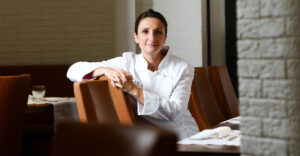For as long as there have been restaurants, there have been women cooking. Yet for much of modern gastronomy, you wouldn’t know it. The Michelin Guide — that elusive constellation chefs chase with feverish devotion — has historically been a male-dominated firmament. Its brightest stars have been men in tall white hats, while women laboured in the background, often unrecognised.
And yet, from the quiet kitchens of Lyon to the gleaming dining rooms of San Francisco, women have been rewriting the story of haute cuisine — sometimes gently, sometimes with a thunderclap.
A History Written in Silence

In 1933, a woman named Eugénie Brazier achieved something extraordinary: six Michelin stars, spread across two restaurants. She was the first chef — of any gender — to reach that milestone. Lyon owes much of its reputation as a culinary capital to her. But while her male contemporaries were canonised as culinary legends, Brazier’s story faded, tucked away in footnotes. It was a pattern: women could cook, but men wrote the history books.
Cracks in the Ceiling

It took decades for the tide to shift, but when it did, it was seismic. Anne-Sophie Pic in France refused to be an afterthought to her family’s legacy. Instead, she created a voice that was unmistakably her own — elegant, surprising, and profoundly modern. She became one of the very few women to hold three stars, proving that delicacy could command as much power as bravado.
Across the Atlantic, Dominique Crenn took things further. In San Francisco, her Atelier Crenn didn’t just serve food; it served poetry — literally, with menus written as verse. When she became the first woman in the United States to earn three Michelin stars, it wasn’t just a personal triumph; it was a crack in the glass ceiling that had long hung over American fine dining.

And then there is Clare Smyth, the Northern Irish chef who once ran Gordon Ramsay’s flagship kitchen. She stepped into her own light with Core by Clare Smyth in London, where vegetables often steal the spotlight from meat — a radical act in a world that has long equated luxury with foie gras and filet mignon. Within two years, she had earned three stars.

Why Their Stars Matter
It would be easy to frame these women as anomalies, but their presence matters for deeper reasons. They bring new flavours to a table that once served only one kind of story. Through them, fine dining has begun to expand its vocabulary: a little more empathy, a little more heritage, a little more refusal to conform.
Where male chefs often built empires, women built connections — to memory, to landscape, to culture. Their menus are not just plates; they are narratives, each course threaded with personal history. Crenn’s French childhood, Pic’s inheritance of a dynasty, Smyth’s working-class Northern Irish roots — these are not footnotes, but ingredients.
A Future Still Unwritten
And yet, women remain a minority in Michelin’s pantheon. The reasons are woven into the fabric of the industry itself: brutal hours, systemic barriers, financial risk. Kitchens are changing, but not fast enough.
Still, the presence of women like Brazier, Pic, Crenn, and Smyth proves one thing: the Michelin stars no longer belong to a single gendered story. They belong to those who dare to cook with conviction, who season their food with memory, and who refuse to let their voices be drowned out by the noise of history.
Perhaps the future of Michelin is not about who climbs the ladder fastest, but about who dares to rewrite the recipe altogether.
